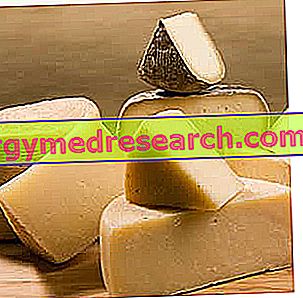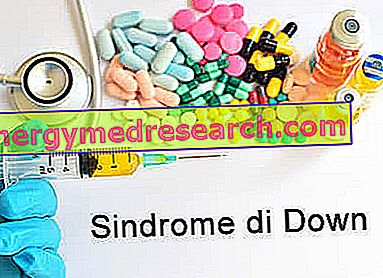Generality
Pecorino is a cheese made from sheep's milk; it is, in particular, a sheep's cheese with a hard paste, since its humidity is less than 40%.

NB . The word "Roman" and "Tuscan" refers to a type of PDO processing that can also be carried out outside the specified area, but in well-defined neighboring areas; this peculiarity is determined by the fact that both the raw material and the manufacturing process of these two cheeses give rise to an almost similar product ALSO just outside the native area.
Production
The production of pecorino varies according to the type of cheese and the area of origin; therefore, below we will try to list the main phases without excluding or omitting any essential step:
- The production of pecorino cheese begins, of course, with sheep milking
- The milk obtained from the milking is highly perishable and can develop "early" some colonies of unwanted bacteria or in any case unsuitable for the success of the pecorino itself; for this reason, the milk is suitably stored raw at 4 ° C until processing, or it is treated with temperatures ranging from 68 to 72 ° C depending on the type of pecorino. NB . The heat treatment of raw milk, on the one hand favors the wholesomeness of the raw material, on the other it compromises some nutritional and organoleptic properties.
- The correction of the milk fat content (skimming) follows, as the pecorino is obtained by eliminating part of the lipid component and proportionally increasing the protein content (a nutrient that is more suitable for the curing process)
- Only at this point does the milk stop or maturation, which allows a spontaneous multiplication of the natural bacterial flora useful for acidification (a process known as "natural grafting"), and which is almost always reinforced with the addition of a manually inoculated biological starter (process called "graft selected"). The bacterial proliferation determines a protein coagulation of the caseins (which, forming a lattice, retain a large part of the fats), which represent the basis for the aging of the pecorino; the liquid component of milk (serum) is instead excluded.
- The ferments of the pecorino are not however sufficient to determine a satisfactory lactic coagulation, therefore it is necessary the curdling (addition of the rennet, a liquid rich in acids and coagulating enzymes, contained in the stomach of calves, lambs and kids); the curdling, which takes place at a temperature of 38-40 ° C, gives rise to the curd.
- Pecorino is a cooked or semi-cooked cheese and this means that, after breaking the curd (coagulated milk mixing process), it is necessary to impose a heat treatment of 15-20 'at 45-58 ° C. This form of cooking, associated with the stirring of the curd, is necessary to further dehydrate the dough, which agglomerates further and excludes excess serum; moreover, the high temperature reached appropriately selects the bacteria useful for maturing (called thermophiles since they resist these temperatures). The broken curd is then pressed.
- What remains is a single large block (of proteins, fats and lactose) that is cut into blocks, placed in special molds and stored in the places of maturation (hot and humid) where the paste is acidified
- After cooling, generally, marking and salting take place, followed by a rest period in cool but very wet rooms
- Finally, we proceed with the actual seasoning, which takes place in cooler but not very humid environments.
Nutritional characteristics
Pecorino is a hard cheese, therefore it is a food derived from processed and concentrated animal milk; specifically, it is a product more or less skimmed, seasoned and salted, all processes that give it some significant nutritional characteristics.
First of all we specify that the pecorino is derived from sheep's milk and that, despite being partially skimmed, it has an initial lipid content higher than the vaccine content; furthermore, by eliminating the serous component during processing, pecorino (like most other cheeses) does NOT use the proteins and lactose it contains. The combination of these two factors determines a nutritional distribution of energy macronutrients in favor of lipids and an extremely high energy density.
Pecorino is still rich in casein proteins, but contains little lactose, which - in addition to flowing mainly with whey - undergoes bacterial fermentation inside the pasta which transforms it into lactic acid during maturation.
Although it is not visible in the tables below, pecorino has a prevalence of fatty acids in favor of saturated ones and a decidedly high cholesterol content; both of these lipids are unhealthy due to the metabolism of people who suffer (or are predisposed) to hypercholesterolemia.
From a vitamin point of view, pecorino contains very high amounts of vitamin B2, of vit. A (retinol) and good concentrations of vit. PP.
As far as mineral salts are concerned, pecorino brings excellent calcium and phosphorus fractions, although the salt content (sodium chloride) makes it unsuitable for hypertensive nutrition.
Pecorino is a preserved food to be consumed occasionally and in limited portions.
Pecorino nutritional composition - Reference values of the INRAN Food Composition Tables
|
| ||||||||||||||||||||||||||||||||||||||||||||||||||||||||||||||||||||||||||||||||||||||||||||||||||||||||||||||||||||||||||||||||||||||||||||||
| |||||||||||||||||||||||||||||||||||||||||||||||||||||||||||||||||||||||||||||||||||||||||||||||||||||||||||||||||||||||||||||||||||||||||||||||






